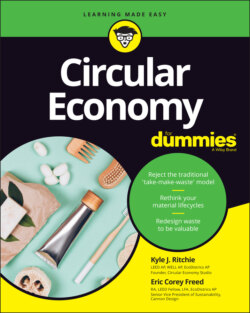Читать книгу Circular Economy For Dummies - Eric Corey Freed - Страница 24
Rejecting the Idea of Waste
ОглавлениеThe current, global economy is based on a take-make-waste platform. Within this management of materials, resources are extracted from the earth (take), processed to form a product (make), and immediately discarded when the product no longer serves a purpose (waste). This management of materials — one where waste plays a critical role — is referred to as linear.
Waste became an accepted component of human life as scarcity of resources diminished. Once abundance was introduced into a large portion of the global economy, there was no need to bother with keeping materials in use. Instead, for some reason, it made sense to the people of that day to simply throw these materials away and start a new lifecycle from scratch. Waste was considered a necessary component of a fruitful and active economy and was often incorporated into the design of products — via planned obsolescence and cheap materials — to ensure a never-ending demand for new products. In addition, by excluding the eventual cost associated with environmental pollution and the impact on human health from material lifecycles, the use of cheap materials has inaccurately been deemed an economically beneficial strategy to make goods and resources affordable.
To create a sustainable management of natural resources, we need to reject immediately the idea that waste is a necessary component of the global economy. In addition, we need to fully design out waste from our material and product lifecycles, by increasing their durability and resilience and by fully recycling materials.
Extracting raw materials from the earth and then shipping them around the world to be processed and manufactured into products that require further shipment before ultimately being used is an extremely wasteful process. The waste associated with the linear economy can be greatly reduced by rethinking waste altogether. Waste isn’t necessary and is instead a resource that has not reached the next step in its lifecycle.
